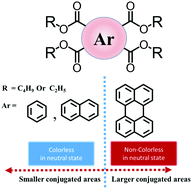Multi-colour electrochromic materials based on polyaromatic esters with low driving voltage†
Abstract
Low-cost single molecular electrochromic (EC) materials with low toxicity are desirable for EC displays and photonic devices. In this study, new EC materials based on phthalates, an inexpensive class of benzoate materials with relatively simple molecular structure, are designed and prepared. Despite being good candidates for EC devices due to clear colour changes when reduced, devices fabricated using phthalate derivatives (PDs) suffer from a high driving voltage. Herein, we propose a facile strategy of replacing the benzene core with polyaromatic esters to enlarge the conjugated area and to synthesise PDs to lower the driving voltage in EC devices. Additionally, devices show good memory effect (hundreds of seconds), the ability to undergo multiple colour changes and enhanced stability, dependent on the size of the conjugated bridge between the two sides of the molecule. The fabricated EC devices based on polyaromatic esters demonstrate a low driving voltage (−2.6 V). We have shown that the number of aromatic ester rings in the conjugated area is very critical to obtain different colours in this new class of EC materials. This series of EC materials has promising potential for future industry applications due to the vivid colour change upon electrochemical stimulation at a low driving voltage.



 Please wait while we load your content...
Please wait while we load your content...